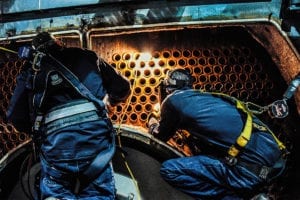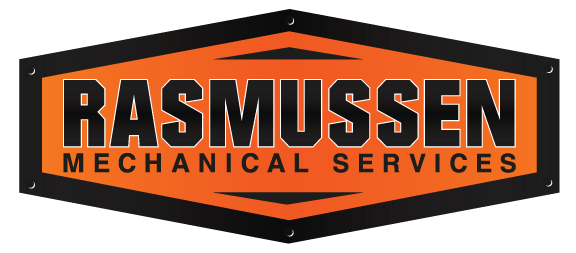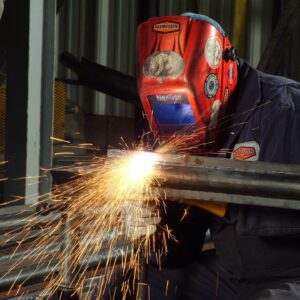Pressure vessels operate under high pressure and temperature. When these units develop a defect or are modified, repairs must meet the National Board Inspection Code. An R Stamp repair validates that work has been completed to those requirements. This guide explains R Stamps, when they are mandatory, the repair sequence, and the considerations for selecting a competent contractor.
At Rasmussen Mechanical Services, we proudly carry an R Stamp.
The Purpose of the R Stamp
An R Stamp is a certification issued by the National Board of Boiler and Pressure Vessel Inspectors. It is given to organizations qualified to repair or alter ASME-stamped pressure equipment according to The National Board Inspection Code (NBIC).
Achieving and maintaining the stamp is not easy. It requires:
- A documented quality-control program that aligns with NBIC rules.
- Qualified welding procedures and certified welders.
- Traceability of materials, inspection records, and nondestructive examinations (NDE).
- A standing agreement with an Authorized Inspection Agency (AIA) to witness repairs and endorse final documentation.
Because the National Board audits each holder at regular intervals, the stamp serves as an external validation of competence, consistency, and code compliance. An R Stamp Certificate of Authorization is valid for three years. To maintain certification, companies must reapply and undergo renewal audits before the expiration date.
Repairs versus Alterations
The NBIC distinguishes between two kinds of work: Repair and Alteration.
Repairs restores the vessel to its original design without changing intent (for example, replacing a cracked nozzle in kind). Alterations modify design pressure, capacity, configuration, or service (for example, increasing Maximum Allowable Working Pressure or installing a larger manway).
Both require an R Stamp organization and Authorized Inspector oversight; alterations demand additional engineering calculations and, frequently, a hydrostatic test at the revised rating.
Situations that Require an R-Stamp
An R Stamp is required for any repair or alteration of pressure-retaining equipment such as:
- Boilers
- Pressure Vessels
- Pressure Piping Systems
- Anhydrous Ammonia Tanks
- Heat Exchangers
This includes any work that affects the “pressure-bearing area” of the equipment. Typical examples include fixing leaks in boiler tubes, repairing cracks in a pressure vessel shell and replacing deteriorated nozzles or flanges. It can also include installing attachments that penetrate the shell and pad welding to restore wall thickness lost to corrosion.
In most cases, the first 36 inches (3 feet) of piping extending from a boiler is considered part of the pressure-retaining system. This piping must also meet the same code requirements.
Who Is Responsible?

Firetube Boiler Repair
The owner or user of the pressure vessel is responsible for ensuring compliance by working with a certified repair organization.
Regulatory authorities and insurance carriers will not allow repairs or alterations to proceed without proper R Stamp documentation.
Risks of Using Non-Certified Companies
Hiring an uncertified company may seem like a quick fix during downtime, but it often leads to greater risks and costs. Jurisdictional inspectors can remove equipment from service and issue fines if undocumented welds are discovered. Insurance may also deny claims for repairs not performed to code, leaving facilities exposed. Unqualified welders often skip critical procedures, leading to hidden defects that fail under pressure. In the end, facilities usually face more costly repairs and longer downtime when the work must be redone by a certified R Stamp contractor.
The R Stamp Repair Sequence
Although each project is unique, repairs tend to follow these seven stages:
- Assessment – A qualified technician inspects the defect, reviews historical data, and determines scope.
- Procedure development – Engineering prepares a written method referencing NBIC sections, welding procedures, and required NDE; cost and schedule are defined.
- Inspector concurrence – The Authorized Inspector reviews and approves the plan before field work begins.
- Preparation – The vessel is isolated, cooled, drained, and made safe; access and safety controls are established.
- Execution – Certified welders perform the work under the approved procedure while quality personnel document each step.
- Inspection and testing – NDE (radiography, ultrasonics, dye-penetrant, etc.) and, when required, pressure testing are completed in the presence of the Inspector.
- Documentation – The organization applies the physical R Stamp or repair nameplate. Then they issue NBIC Form R-1 (repair) or R-2 (alteration), and provides a complete record package for the owner’s files.
A moderate shell repair can often be completed—including paperwork—within 48 to 72 hours, provided the procedure is planned and approved without delay.
 Selecting a Competent R Stamp Contractor
Selecting a Competent R Stamp Contractor
When selecting a competent R Stamp contractor, verify their current authorization by requesting a copy of their Certificate of Authorization. You can the check its validity through the National Board directory. Additionally, ensure the contractor has relevant experience working on equipment similar to yours in terms of size, material, and service conditions.
Organizations holding additional ASME stamps such as “U,” “S,” or “PP” can fabricate replacement components internally, which can significantly shorten project timelines. Finally, assess the contractor’s responsiveness, as the capability to rapidly mobilize personnel, equipment, and an Authorized Inspector can be critical during unexpected outages.
Maintaining Compliance after the Repair
Upon restart, retain all repair documentation—digital and hard-copy—indefinitely. Incorporate inspection of the repaired area into the next scheduled outage, and share findings across facilities operating similar equipment. Continuous review of inspection data helps anticipate emerging issues and plan proactive maintenance.
 Industries that Commonly Require R Stamp Repair
Industries that Commonly Require R Stamp Repair
Facilities in power generation, chemical processing, ethanol, food production, and healthcare often encounter situations where they require an R Stamp Repair. These industries operate under strict regulatory oversight, and timely, certified repairs are essential to avoid production losses and legal penalties.
R Stamp Repair Conclusion
In summary, an R Stamp is a critical certification for the repair and alteration of pressure-retaining equipment. This includes boilers, pressure vessels, and pressure piping systems. The National Board of Boiler and Pressure Vessel Inspectors issues stamps. They ensure that repairs meet the highest standards for safety, reliability, and compliance with the National Board Inspection Code (NBIC).
To earn this certification, a company must undergo a rigorous process, including regular audits, employing qualified technicians, and demonstrating strict adherence to industry codes. Any repair or alteration involving pressure-retaining equipment requires a company that carries the stamp. This commonly includes fixing leaks in boiler tubes, repairing cracks in pressure vessels, or modifying pressure systems. Typically, the first 36 inches of piping from a boiler are part of the pressure-retaining system and require the stamp for repairs. R Stamp-certified companies, like Rasmussen Mechanical Services, offer boiler and pressure vessel repairs and structural modifications. Contact us for an r stamp repair at 1-800-237-3141.



 Selecting a Competent R Stamp Contractor
Selecting a Competent R Stamp Contractor  Industries that Commonly Require R Stamp Repair
Industries that Commonly Require R Stamp Repair